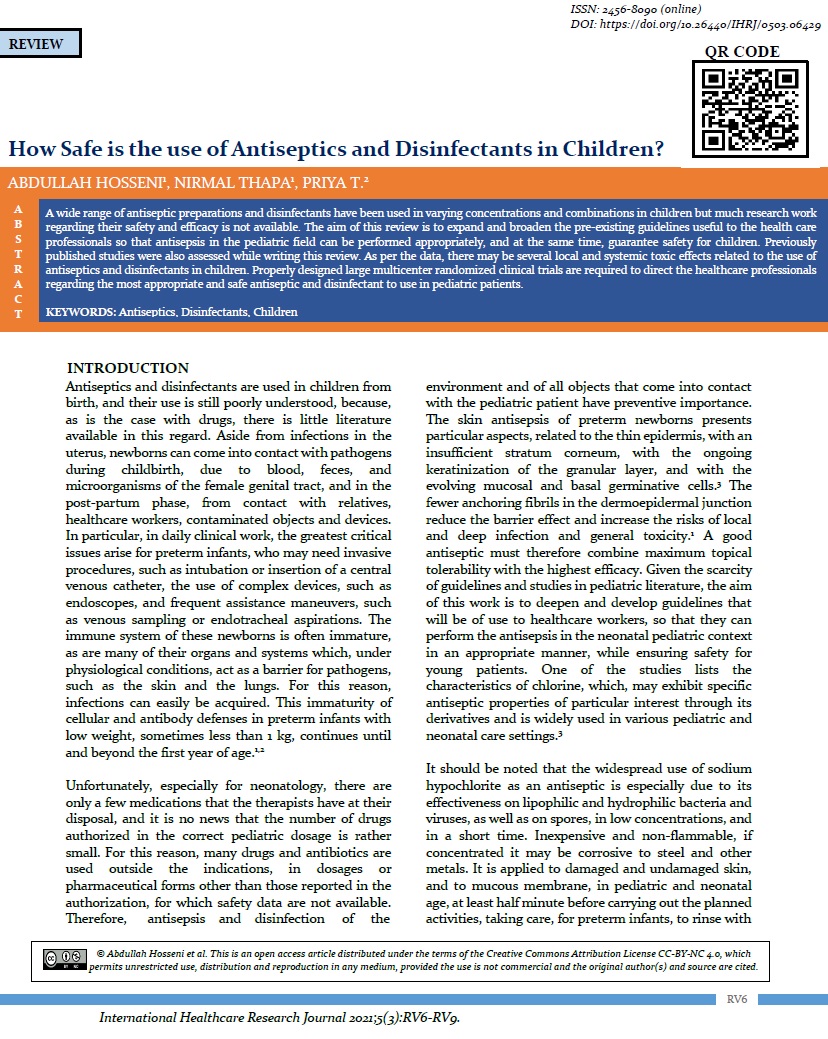How Safe is the use of Antiseptics and Disinfectants in Children?
Abstract
A wide range of antiseptic preparations and disinfectants have been used in varying concentrations and combinations in children but much research work regarding their safety and efficacy is not available. The aim of this review is to expand and broaden the pre-existing guidelines useful to the health care professionals so that antisepsis in the pediatric field can be performed appropriately, and at the same time, guarantee safety for children. Previously published studies were also assessed while writing this review. As per the data, there may be several local and systemic toxic effects related to the use of antiseptics and disinfectants in children. Properly designed large multicenter randomized clinical trials are required to direct the healthcare professionals regarding the most appropriate and safe antiseptic and disinfectant to use in pediatric patients.
Downloads
References
Agolini G, Tansini G, De Vonderweid U. Infezioni Neonatali. Testo D. 2006; 30-9.
Baldan R, Cavallerio P, Parlato C, Rocchetti A, Lomolino G et al. Meticillin-resistant Staphylococcus aureus SCCmec type IV: nosocomial transmission and colonisation of healthcare workers in a neonatal intensive care unit. J Hosp Infect. 2008;69(3):304-6. https://doi.org/10.1016/j.jhin.2008.04.002.
Agolini G, Faldella G, Janes E, Raitano A, Spinelli M et al. Problemi di antisepsi nei neonati prematuri [Skin antisepsis in premature infants]. Pediatr Med Chir. 2011 Jul-Aug;33(4):169-77. Italian. Erratum in: Pediatr Med Chir. 2012;34(3):154.
Kutsch J, Ottinger D. Neonatal skin and chlorhexidine: a burning experience. Neonatal Netw. 2014 Jan-Feb;33(1):19-23. https://doi.org/10.1891/0730-0832.33.1.19.
Lashkari HP, Chow P, Godambe S. Aqueous 2% chlorhexidine-induced chemical burns in an extremely premature infant. Arch Dis Child Fetal Neonatal Ed. 2012;97(1):F64. https://doi.org/10.1136/adc.2011.215145. Epub 2011 Jul 11. PMID: 21746795.
Borghesi A, Stronati M. Strategies for the prevention of hospital-acquired infections in the neonatal intensive care unit. J Hosp Infect. 2008;68(4):293-300. https://doi.org/10.1016/j.jhin.2008.01.011.
Blaney M, Shen V, Kerner JA, Jacobs BR, Gray S et al. Alteplase for the treatment of central venous catheter occlusion in children: results of a prospective, open-label, single-arm study (The Cathflo Activase Pediatric Study). J Vasc Interv Radiol. 2006;17:1745-51. https://doi.org/10.1097/01.RVI.0000241542.71063.83.
Marschall J, Mermel LA, Fakih M, Hadaway L, Kallen A et al. Strategies to prevent central line-associated bloodstream infections in acute care hospitals: 2014 update. Infect Control Hosp Epidemiol. 2014;35(7):753-71. https://doi.org/10.1086/676533.
O'Grady NP, Alexander M, Burns LA, Dellinger EP, Garland J et al. Guidelines for the prevention of intravascular catheter-related infections. Clin Infect Dis. 2011 May;52(9):e162-93. https://doi.org/10.1093/cid/cir257.
Curry S, Honeycutt M, Goins G, Gilliam C. Catheter-associated bloodstream infections in the NICU: getting to zero. Neonatal Netw. 2009;28(3):151-5. https://doi.org/10.1891/0730-0832.28.3.151.
Levy I, Katz J, Solter E, Samra Z, Vidne B, Birk E, Ashkenazi S, Dagan O. Chlorhexidine-impregnated dressing for prevention of colonization of central venous catheters in infants and children: a randomized controlled study. Pediatr Infect Dis J. 2005;24(8):676-9. https://doi.org/10.1097/01.inf.0000172934.98865.14.
Williams GJ, Denyer SP, Hosein IK, Hill DW, Maillard JY. Use of sodium dichloroisocyanurate for floor disinfection. J Hosp Infect. 2009;72(3):279-81. https://doi.org/10.1016/j.jhin.2009.02.017.

Copyright (c) 2021 Abdullah Hosseni et al.

This work is licensed under a Creative Commons Attribution-NonCommercial 4.0 International License.


